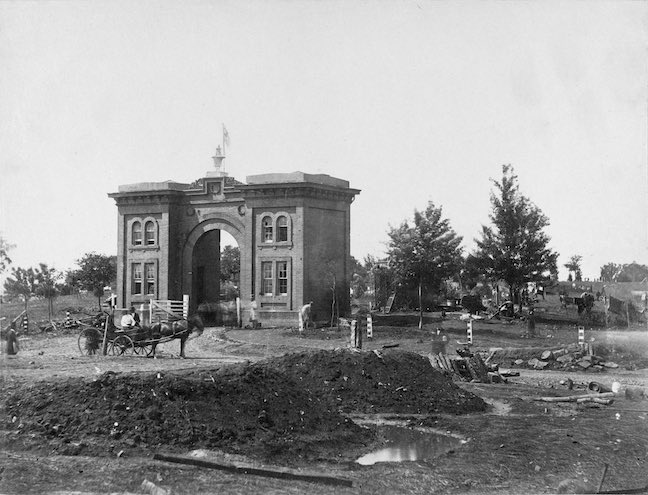| Credit: | by OSullivan (Timothy H.) |
|---|---|
| Date: | 1863.07 |
| Negative Size: | 8 in. x 10 in. |
| Equipment: | horse |
| Locations & Lines: | Adams County PA; Cemetery Ridge PA; Gettysburg battlefield PA; Pennsylvania |
| Military Units: | CS Army; US Army |
| Structures & Establishments: | Evergreen Cemetery Gatehouse (Adams County PA) |
| Transports: | horse-drawn carriage |
| Sources: | Library of Congress; National Archives |
$6.99
File Details: AIKTm, 800 DPI, TIFF, Original Photograph, 42.5 Mb
Image ID: AIKT
Gardners Photographic Sketch Book Of The War. Vol. 1, No. 39. Gateway of Cemetery, Getttysburg. July, 1863. Cemetery Ridge was the scene of some of the severest fighting at Gettysburg. The knoll shown in the sketch is that upon which the last assault of the enemy was made, and on which is situated the National Soldiers Cemetery. The original cemetery was a very handsome enclosure, and contained many elegant monuments, very few of which were injured, notwithstanding the terrible nature of the conflict. The shrubbery was badly broken, and the fence swept away, but at the conclusion of the fight there still remained, as if in mockery, the notice, All persons found using fire-arms in these grounds will be prosecuted with the utmost rigor of the law. The third days fight was in front of this spot, and was commenced about one oclock in the afternoon by the enemy a cannonade from 120 pieces of artillery on the front of the line connecting Cemetery Ridge with Round Top. Gen. Hancock, in one of his reports, says: That cannonade continued for probably an hour and a half. The enemy then made an assault at the end of that time; it was a very formidable assault, and made, I should judge, with about 18,000 infantry. When the columns of the enemy appeared, it looked as if they were going to attack the centre of our line, but after marching straight out a little distance they seemed to incline a little to their left, as if their object was to march through my command and seize Cemetery Hill, which, I have no doubt, was their intention. They attacked with wonderful spirit; nothing could have been more spirited. The shock of the assault fell upon the Second and Third Divisions of the Second Corps, and these were the troops, assisted by the small brigade of Vermont troops, together with the artillery of our line, which fired from Round Top to Cemetery Hill at the enemy, all the way, as they advanced, whenever they had the opportunity. Those were the troops that really met the assault. No doubt there were other troops that fired a little, but those were the troops that really withstood the shock of the assault and repulsed it. The attack of the enemy was met by about six small brigades of our troops, and was finally repulsed after a terrific contest at very close quarters, in which our troops took about thirty or forty color, and some four thousand or five thousand prisoners, with great loss to the enemy in killed and wounded. The repulse was a most signal one and that decided the battle, and was practically the end of the fight. Here President Lincoln attended the consecration of the Soldiers National Monument, erected to the memory of the heroic men who fell in that struggle. The shattered trees and crushed flowers have all been replaced by others, whose beauty and fragrance we may confidently hope shall never be again blasted by war.
